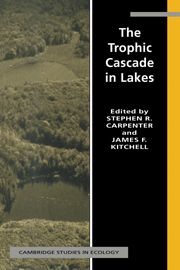Book contents
- Frontmatter
- Contents
- Contributors
- Preface
- 1 Cascading trophic interactions
- 2 Experimental lakes, manipulations and measurements
- 3 Statistical analysis of the ecosystem experiments
- 4 The fish populations
- 5 Fish behavioral and community responses to manipulation
- 6 Roles of fish predation: piscivory and planktivory
- 7 Dynamics of the phantom midge: implications for zooplankton
- 8 Zooplankton community dynamics
- 9 Effects of predators and food supply on diel vertical migration of Daphnia
- 10 Zooplankton biomass and body size
- 11 Phytoplankton community dynamics
- 12 Metalimnetic phytoplankton dynamics
- 13 Primary production and its interactions with nutrients and light transmission
- 14 Heterotrophic microbial processes
- 15 Annual fossil records of food-web manipulation
- 16 Simulation models of the trophic cascade: predictions and evaluations
- 17 Synthesis and new directions
- References
- Index
4 - The fish populations
Published online by Cambridge University Press: 06 August 2010
- Frontmatter
- Contents
- Contributors
- Preface
- 1 Cascading trophic interactions
- 2 Experimental lakes, manipulations and measurements
- 3 Statistical analysis of the ecosystem experiments
- 4 The fish populations
- 5 Fish behavioral and community responses to manipulation
- 6 Roles of fish predation: piscivory and planktivory
- 7 Dynamics of the phantom midge: implications for zooplankton
- 8 Zooplankton community dynamics
- 9 Effects of predators and food supply on diel vertical migration of Daphnia
- 10 Zooplankton biomass and body size
- 11 Phytoplankton community dynamics
- 12 Metalimnetic phytoplankton dynamics
- 13 Primary production and its interactions with nutrients and light transmission
- 14 Heterotrophic microbial processes
- 15 Annual fossil records of food-web manipulation
- 16 Simulation models of the trophic cascade: predictions and evaluations
- 17 Synthesis and new directions
- References
- Index
Summary
Introduction
Fundamental to the cascade hypothesis are the effects that fish populations can exert on species composition, biomass and productivity at other trophic levels. These may be direct or indirect (nonlethal) effects. Direct effects such as prey consumption, and indirect effects such as those influencing behavior (avoidance of predators) have been widely documented at the population level (e.g. Stroud & Clepper, 1979; Werner et al., 1983) and the indirect effects expressed at the community and ecosystem levels such as those reviewed in Kerfoot & Sih (1987) & Northcote (1988). Indirect effects pertinent in the case of our studies would include behavioral responses, such as migration from or selection of specific refugia from predation (e.g. diel vertical migration of zooplankton and onshore–offshore migration of small fishes), that result in changes in foraging patterns of prey species (Carpenter et al., 1987; He & Kitchell, 1990; He & Wright, 1992; Chapter 5). Another category of effects includes changes in nutrient flux due to shifts in the behavioral or structural properties of the fish populations (Carpenter et al., 1992b).
Fish in our study lakes (Fig. 4.1) are common to the Great Lakes region, but some are near the limits of their geographic distributions. Largemouth bass and golden shiner are at the northern limits, while finescale and northern redbelly dace are near the southern limits (Scott & Crossman, 1973; Becker, 1983). Adult largemouth bass and rainbow trout can be keystone piscivores (Keast, 1985; Carpenter et al., 1985, 1987) with an ability to limit the abundance of forage fish.
- Type
- Chapter
- Information
- The Trophic Cascade in Lakes , pp. 43 - 68Publisher: Cambridge University PressPrint publication year: 1993
- 15
- Cited by



